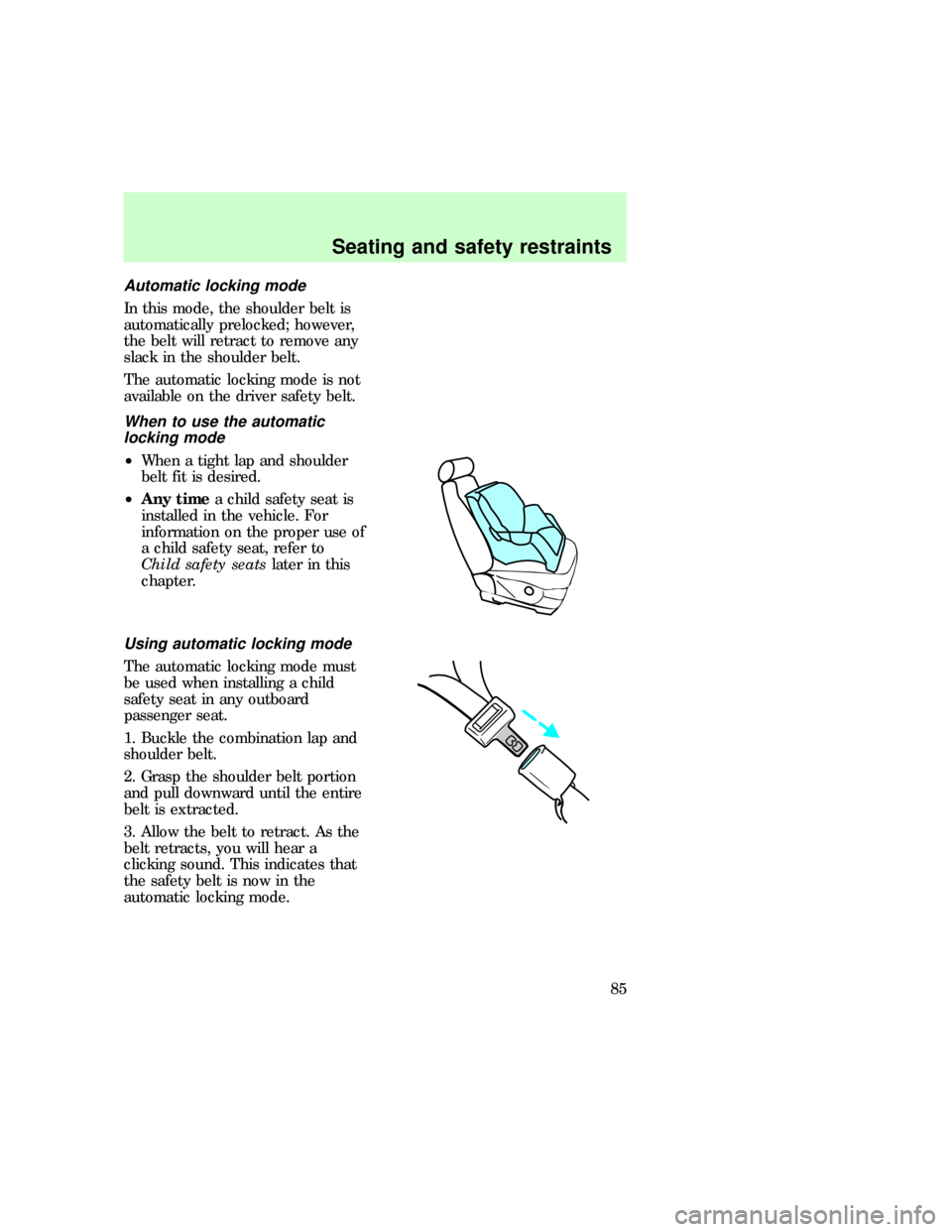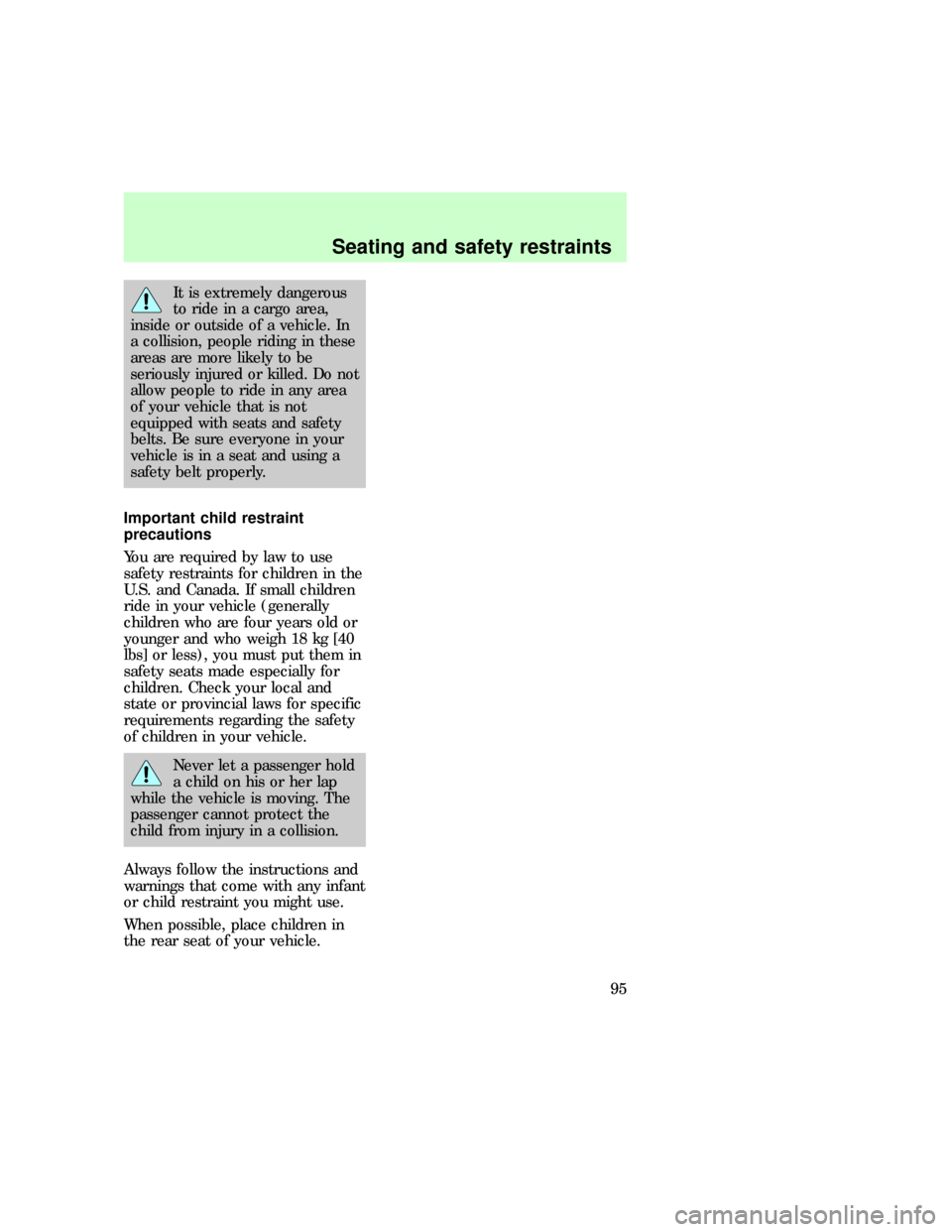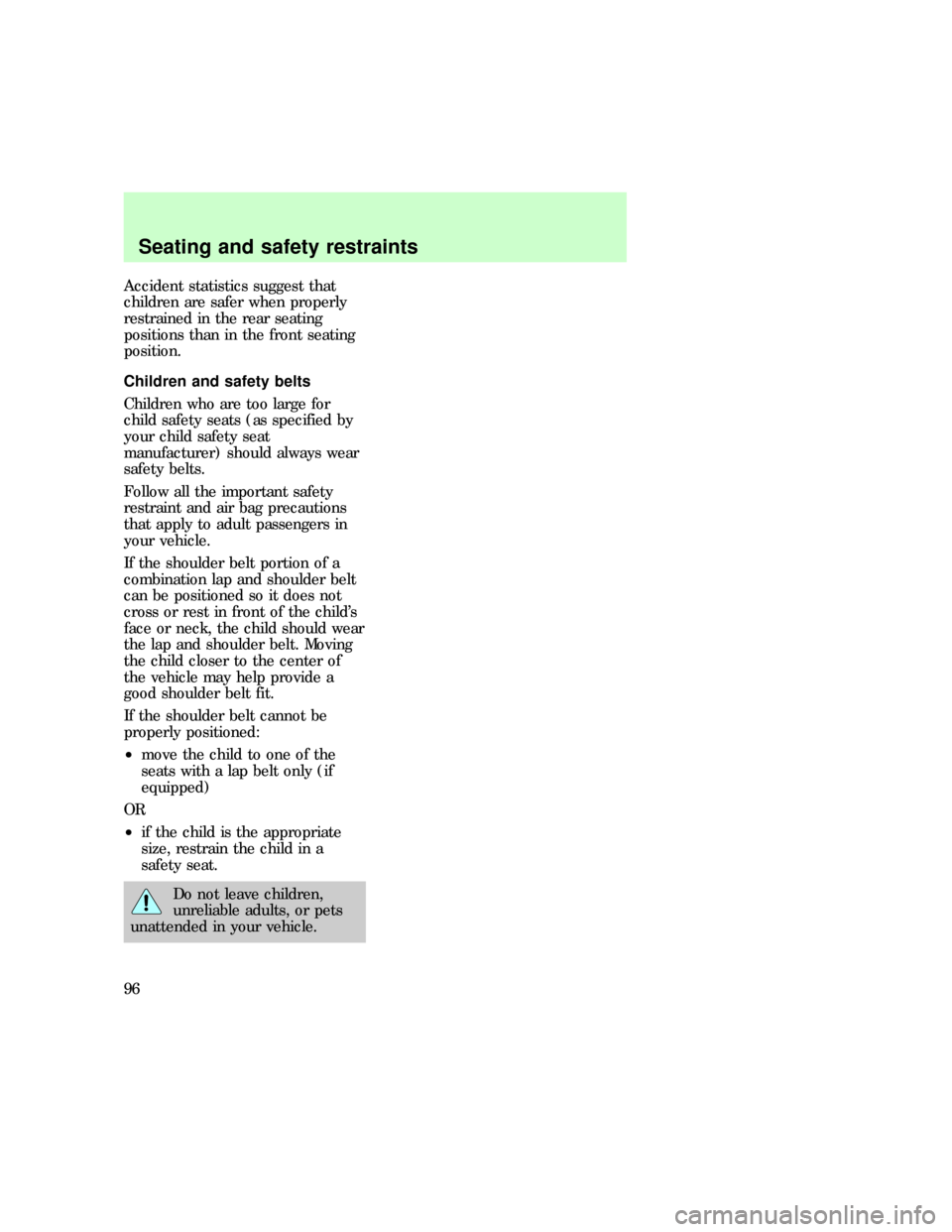Page 78 of 236
SEATING
Adjusting bench seating
Folding rear seats (if equipped)
If your vehicle is equipped with a
built-in child safety seat, the
seatback cannot be folded down
unless the built-in child seat is
fully stowed.
1. Press the lower release control
downward to unlatch the seatback.
2. Rotate the seatback downward
into the load floor position.
3. Press down on the top outboard
area of the seatback until a click is
heard. The seat is now latched in
the load floor position.
Returning to the upright
position
1. Press downward on the upper
outboard corner of the seatback
and hold.
2. Pull the release handle upward
to unlatch the seat.
3. Rotate the seatback upward
until the seatback latches in the
upright position. The seatback will
click when it is locked into
position.
uno_adjusting_bench
uno_adjust_man_bucket
Seating and safety restraints
79
Page 82 of 236
SAFETY RESTRAINTS
Important safety restraints
precautions
The use of safety belts helps to
restrain both driver and passengers
in case of a collision. In most
states and Canada, the law
requires the use of safety belts.
Always drive and ride with
your seatback upright and
the lap belt snug and low across
the hips.
Lock the doors of your
vehicle before driving to
lessen the risk of the door
coming open in a collision.
Cargo should always be
secured to prevent it from
shifting and causing damage to
the vehicle or harm to
passengers.
To prevent the risk of
injury, make sure children
sit where they can be properly
restrained.
uno_safety_res_prec
uno_using_sr_properly
Seating and safety restraints
83
Page 84 of 236

Automatic locking mode
In this mode, the shoulder belt is
automatically prelocked; however,
the belt will retract to remove any
slack in the shoulder belt.
The automatic locking mode is not
available on the driver safety belt.
When to use the automatic
locking mode
²When a tight lap and shoulder
belt fit is desired.
²Any timea child safety seat is
installed in the vehicle. For
information on the proper use of
a child safety seat, refer to
Child safety seatslater in this
chapter.
Using automatic locking mode
The automatic locking mode must
be used when installing a child
safety seat in any outboard
passenger seat.
1. Buckle the combination lap and
shoulder belt.
2. Grasp the shoulder belt portion
and pull downward until the entire
belt is extracted.
3. Allow the belt to retract. As the
belt retracts, you will hear a
clicking sound. This indicates that
the safety belt is now in the
automatic locking mode.
uno_when_to_use_almode
uno_using_auto_locking_mode
uno_cancel_air
Seating and safety restraints
85
Page 89 of 236
Failure to follow these
instructions will affect the
performance of the safety belts
and increase the risk of personal
injury.
The right front passenger
air bag is not designed to
restrain occupants in the front
seating position.
Do not place objects or
mount equipment on or
near the air bag covers that may
come into contact with an
inflating air bag.
Do not attempt to service,
repair, or modify the Air
Bag Supplemental Restraint
System or its fuses. See your
Ford or Lincoln-Mercury dealer.
Children and air bags
For additional important safety
information, read all information
on safety restraints in this guide.
Children should always wear their
safety belts. Failure to follow these
instructions may increase the risk
of injury in a collision.
com_children.01
Seating and safety restraints
90
Page 90 of 236
Rear-facing child seats or
infant carriers should
never be placed in the front
seats.
How does the air bag
supplemental restraint system
(SRS) work?
The SRS is designed to activate
when the vehicle is in a collision,
similar to hitting a fixed barrier
head on at 12±24 km/h (8±14
mph).
The fact that the air bags did not
inflate in a collision does not mean
that something is wrong with the
system. Rather, it means the forces
were not of the type sufficient to
cause activation.
uno_how_work
Seating and safety restraints
91
Page 93 of 236
Disposal of air bags and air bag
equipped vehicles
For disposal of air bags or air bag
equipped vehicles, see your local
dealership or qualified technician.
Air bags MUST BE disposed of by
qualified personnel.
CHILDREN AND SAFETY
RESTRAINTS
To prevent the risk of
injury, make sure children
sit where they can be properly
restrained.
Do not leave children,
unreliable adults, or pets
unattended in your vehicle.
Safety belts and seats can
become hot in a vehicle
that has been closed up in sunny
weather; they could burn a small
child. Check seat covers and
buckles before you place a child
anywhere near them.
uno_child
Seating and safety restraints
94
Page 94 of 236

It is extremely dangerous
to ride in a cargo area,
inside or outside of a vehicle. In
a collision, people riding in these
areas are more likely to be
seriously injured or killed. Do not
allow people to ride in any area
of your vehicle that is not
equipped with seats and safety
belts. Be sure everyone in your
vehicle is in a seat and using a
safety belt properly.
Important child restraint
precautions
You are required by law to use
safety restraints for children in the
U.S. and Canada. If small children
ride in your vehicle (generally
children who are four years old or
younger and who weigh 18 kg [40
lbs] or less), you must put them in
safety seats made especially for
children. Check your local and
state or provincial laws for specific
requirements regarding the safety
of children in your vehicle.
Never let a passenger hold
a child on his or her lap
while the vehicle is moving. The
passenger cannot protect the
child from injury in a collision.
Always follow the instructions and
warnings that come with any infant
or child restraint you might use.
When possible, place children in
the rear seat of your vehicle.
uno_important_precautions
Seating and safety restraints
95
Page 95 of 236

Accident statistics suggest that
children are safer when properly
restrained in the rear seating
positions than in the front seating
position.
Children and safety belts
Children who are too large for
child safety seats (as specified by
your child safety seat
manufacturer) should always wear
safety belts.
Follow all the important safety
restraint and air bag precautions
that apply to adult passengers in
your vehicle.
If the shoulder belt portion of a
combination lap and shoulder belt
can be positioned so it does not
cross or rest in front of the child's
face or neck, the child should wear
the lap and shoulder belt. Moving
the child closer to the center of
the vehicle may help provide a
good shoulder belt fit.
If the shoulder belt cannot be
properly positioned:
²move the child to one of the
seats with a lap belt only (if
equipped)
OR
²if the child is the appropriate
size, restrain the child in a
safety seat.
Do not leave children,
unreliable adults, or pets
unattended in your vehicle.
uno_safety_belts
Seating and safety restraints
96